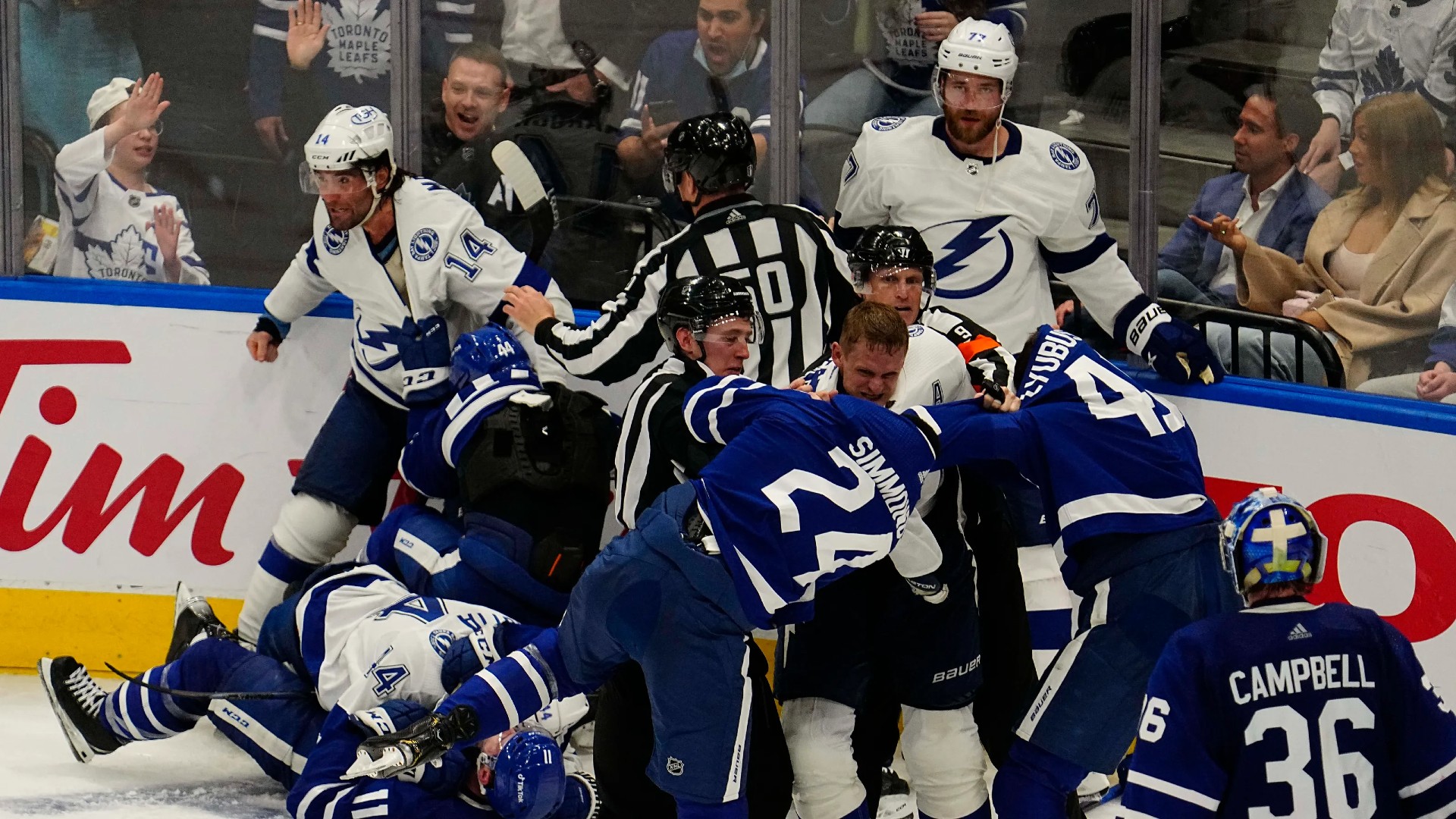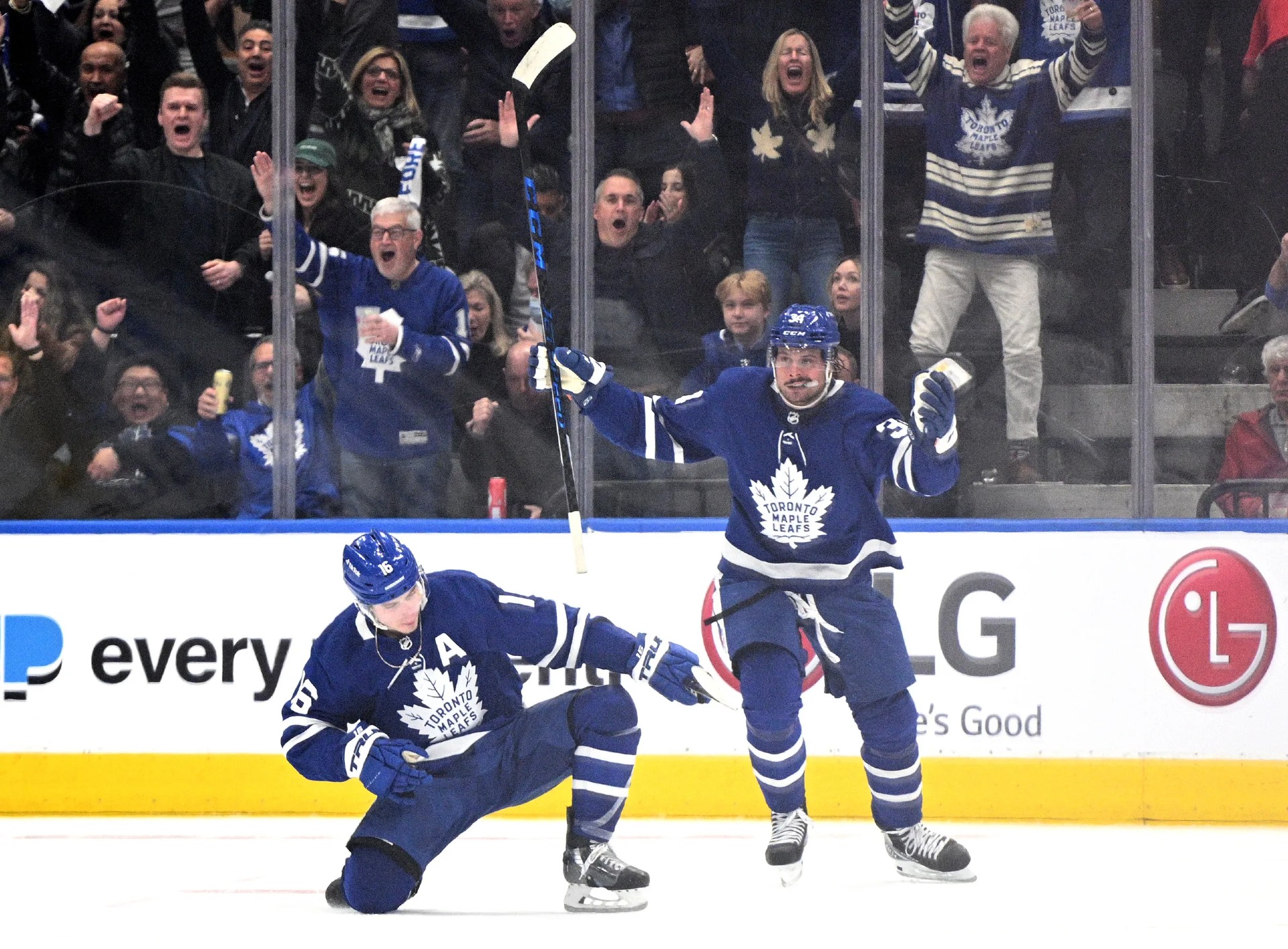It had been 11 months since the Toronto Maple Leafs last played a postseason hockey game when the team took the ice last night at Scotiabank Arena.
As the 2021-22 regular season rolled along, with franchise records for wins and points crumbling and Auston Matthews breaking his own club records, the opinion of much of the fanbase went something like this: “Cool, but it means nothing if it doesn’t happen in the playoffs.”
The 2022 Stanley Cup Playoffs are just one day old, but we got this Leafs team’s opening statement last night to the fanbase and hockey world at large. It was a whopper.
With a packed house of fans clad in blue and white, the energy from the seats seemed to seep onto the ice. The Maple Leafs were buzzing from the opening few minutes, and the impact of the home crowd on the game was notable. They fed off the audience, killing off a five-minute major in style, and then the offense took over. They scored at 5v5. Then on the PP. Then on the PK. Then at 5v5 again.
Before you knew it, the 2x defending champion Tampa Bay Lightning had taken a figurative uppercut to the mouth and were laying motionless on the mat, losing to the shocking tune of 5-0. Game 2 will be all about Tampa’s response and the Leafs‘ ability to manage it, but for today, let’s talk about that figurative (and somewhat literal) punch that Toronto threw last night.
Three Turning Points

Looking at the 60 minutes overall, there were three pivotal moments that swung the trajectory of the game. Of course, every hockey game consists of dozens of these turning points, but when you take the bird’s eye view, three tower above the rest.
The first came about seven minutes in when Kyle Clifford rammed Ross Colton from behind face-first into the boards. The Lightning power play was a major storyline entering this series, pouring in goals with wild abandon over their final eight games of the regular season (14 for the last 29). Tampa had already gotten one crack on the PP in the first period before the Clifford hit after TJ Brodie was penalized for hooking. The Leafs killed that one off just fine, but the Clifford penalty, (correctly) deemed a five-minute major and game misconduct, was going to give the ultra-potent Tampa PP a golden opportunity to set the tone.
Leafs fans whose minds reside in the “everything that can go wrong, will go wrong” universe were probably bracing for multiple goals against. You don’t have to think that far back to remember 2019 when Boston pouring in goals with the man-advantage was one of the key deciders in that series. Most of the time, when you give a power play consisting of Steven Stamkos, Brayden Point, Alex Killorn, Nikita Kucherov, and Victor Hedman five minutes to work with, they’re going to make you pay. Last night, they didn’t. Because the Leafs wouldn’t let them.
I’ve watched a lot of hockey in my life, and I’m not sure I’ve seen a worse five-minute PP at the NHL level. If we’re curving the grading based on the level of talent on the ice for Tampa, it’s not even close. The Lightning struggled to penetrate the Toronto defensive zone for five straight minutes, and the Leafs generated multiple shorthanded rushes.
The PK work of forwards Alex Kerfoot, David Kämpf, Ilya Mikheyev, Pierre Engvall and Mitch Marner was excellent in two areas: they clogged up the neutral zone, forcing the Lightning to either shoot the puck in or make a quick pass after entering, and they were very quick to cut off those passing lanes.
Alongside defensemen Jake Muzzin, TJ Brodie, Mark Giordano, and Timothy Liljegren, the Leafs were aggressive taking away passing lanes and winning puck battles. This was the first time in the game where Toronto’s energy level showed through in such a stark manner. They were quicker and more aggressive, asserting themselves on the puck as the shorthanded team.
Though none of the three SH rush chances they generated went in, killing off that penalty in dominant fashion turned the game on its head. The Leafs saw the car veering towards a multi-goal Tampa lead when Clifford was sent off and snagged the steering wheel, wresting control back from their opposition.
The second turning point came about eight minutes later. The Leafs had gotten a few chances over two power-play opportunities, but the game was still scoreless. Tampa had returned to even strength after killing an infraction billed to Mikhail Sergachev when Ondrej Kaše and Mikheyev went to work on the forecheck. Kaše got his stick on a Hedman pass, Mikheyev tied up its intended target (Erik Cernak), Kaše passed it to the point. Muzzin received the pass and stepped into a blast from just inside the blue line and it beat Andrei Vasilevskiy:
Muzzin's blast fines twine. 1-0 Leafs #LeafsForever pic.twitter.com/ZxbFsi4Qmg
— Maple Leafs Hotstove (@LeafsNews) May 3, 2022
Watch what Mikheyev does: as soon as he sees Kaše has the puck, he heads to the front of the net to screen Vasilevskiy. The Leafs had Mikheyev screening several other times in the game, including on the PP, and it seemed to be part of the game plan.
I was re-watching the highlights of the 2019 Tampa-Columbus series recently to get a look at what it was like the last time Vasilevskiy appeared mortal in the playoffs. A disproportionate number of the goals that the Jackets scored came just like that: from perimeter shots through traffic, with multiple bodies obscuring Vasilevskiy’s sightline.
While the seeing-eye-point shot has gone somewhat out of style in part due to the rise of the analytics era that stresses higher quality looks, as well as the rise of the 1-3-1 PP as a tactical system, it has its value in the right situations, especially at playoff time. It’s impossible to get to the prime scoring areas on every possession, particularly in the playoffs, and not all perimeter shots are created equal. A superstar netminder is not going to get beat clean very often, even on high-danger looks, if he can see it all the way. You have to rattle him with bodies moving in front. The Leafs seemed committed to it, and they were rewarded on that Muzzin goal.
The third turning point came midway through the second period. The Leafs were now leading 2-0, in control of the game but still with tons of hockey to play. The Lightning were set to go on yet another power play, and a goal at that juncture completely changes the complexion of the game. And it did, except the goal wasn’t scored by Tampa.
Tampa had possession in the Toronto end, Hedman took a shot that Kämpf blocked with his body, and the puck subsequently went down below the goal line. A battle ensued, Marner got to it, and he swung it out to clear. Hedman got a piece at the blue line, but the puck squibbed out to the center ice area. A race ensued, with Kämpf moving in a straight line against Hedman in a diagonal, and the Czech beat the Swede. Kämpf was away, and he beat Vasilevskiy:
Kampf scores a big SH goal. 3-0 Leafs #LeafsForever pic.twitter.com/03DC1BXnlJ
— Maple Leafs Hotstove (@LeafsNews) May 3, 2022
At that moment, the game went from “the Leafs are in a good spot” to “this is really their night.” A chance to narrow it to 2-1 instead made it 3-0. The meltdown didn’t happen, the game entered cruise control, and the Leafs were up 1-0 in the series.
Any of those three moments — the five-minute PP, the opening Muzzin goal, and the Kämpf shorthanded goal — had the potential to alter the game’s course and outcome. Sometimes it doesn’t come down to producing expected goals but making critical plays at key moments in the game. The Toronto Maple Leafs made those plays last night.
Notable Performances

Auston Matthews scored more goals in last night’s Game 1 than he did in the entire series against Montreal. If you ask me to give you a fourth turning point, the 5v3 goal from Matthews to make it 2-0 would’ve been my answer. Anthony Pietrielli noted this in the game review last night, but it was a designed play to get Matthews skating into the shot, as he tracked back to the blue line before charging down to receive the puck and blast it into the net.
Recall that Matthews was skating downhill (with the puck in this case) for his 60th against Detroit, where he wheeled around the zone on the PP and was able to pick up speed before ripping it by the goalie. It can be hard to pick up speed on a stationary power play, but the Leafs may have found a wrinkle that helps improve the lethality of an already deadly marksman.
His second goal was mostly a gift from the end-boards — a generous bounce past Vasilevskiy, leaving the net exposed — but it was still good to see Matthews convert when the chance presented itself. AM34 got plenty of chances in last season’s playoffs but converted on only one. Tonight he got a few, registering six shots on goal, and converted on two.
He looked visibly engaged and energetic, and it’s hard to underrate how important it was for the Leafs not just to put in a full 60-minute effort, but to be rewarded repeatedly for that effort. It’s the kind of confidence this group so desperately needed after last May.
Following Matthews, we have to talk about Mitch Marner. He shattered the 19-game playoff goal drought with a dandy late in the second period that tightened the stranglehold. Marner’s time-on-ice distribution in this game was fascinating, logging ~five minutes on the PK, ~seven minutes on the PP, and ~seven minutes at even strength, of which only 5.5 was at 5v5. Entering the third period, Marner had already played 15 minutes, and Sheldon Keefe did the right thing to cut down on #16’s usage in that period, finishing with 19:18 in total.
It’s difficult to assess Marner’s performance in vivid detail at 5v5 because the sample size was so small, but he was an undeniably effective hockey player tonight across the three strengths at which he played. He got a primary assist on the Matthews 5v3 goal, a primary assist on the Kämpf shorthanded goal, and his own goal came at even strength.
Like Matthews, Marner seemed far more alive and plugged in than he did late in last year’s playoff series, and the energy and emotion he played with needs to be carried over to Wednesday. Marner and Matthews finished as Toronto’s two best forwards at even strength in Evolving Hockey’s numbers, with the Leafs owning ~90% of the expected goals with those two on the ice.
William Nylander didn’t end up on the scoresheet, but it wasn’t for a lack of trying. Nylander was the most notable Leaf early on, using his speed to burn in for a chance around the Tampa defense in the game’s opening minutes and he also got a breakaway chance at the end of the first. His four shots on goal were third on the team, and the Leafs owned 68.1% of the expected goals with Nylander on the ice at even strength. Nylander replicating last playoffs will greatly improve the Leafs’ odds of winning this series, and yesterday was a step in the right direction.
How about Pierre Engvall? Another forward who didn’t find the scoresheet, but Engvall registered five shots on goal last night and was dominant in both the eye test and the analytics. He was noticeable on the penalty kill and at 5v5, using his speed to threaten off the rush and using his size to mix it up on the forecheck and in the defensive zone. The Leafs as a team showed far more of a physical edge in this game than they did at any point against Montreal in 2021, and Engvall was perhaps the personification of that. This after-whistle scuffle with Brandon Hagel stood out:
Pierre Engvall is mad pic.twitter.com/QWrhwt0NDv
— Omar (@TicTacTOmar) May 3, 2022
The Leafs had seven scoring chances with Engvall on the ice, to just three for Tampa, and he did it despite starting just once in the offensive zone, compared to six times in the defensive zone. Turning defense into offense was the name of Engvall’s game in this one, and when Toronto’s role players are outplaying Tampa’s, that’s a really good sign.
TJ Brodie deserves a shoutout for being a defensive stalwart in this game. He broke up a potential high-danger pass by Nikita Kucherov at the tail-end of the five-minute major in the first and then drew a penalty on Kucherov shortly thereafter. Later on, he blocked a Steven Stamkos blast, one of three blocks on the night for him. Brodie took one shot on goal, threw two hits, blocked three shots, and the Leafs owned 74.3% of the expected goals with him on the ice at even strength. He played a team-leading 22:47 TOI, which included a whopping 6:42 shorthanded.
Piggybacking off of Brodie, Jake Muzzin scored the aforementioned opening goal and also logged over 22 minutes on ice last night. Muzzin led the team’s defensemen with over seven minutes on ice shorthanded and also led the team with six hits. Combined with three blocks and two shots on goal, it was a vintage effort from the veteran.
Mark Giordano and Timothy Liljegren were both good for the Leafs as well. Both logged substantial time shorthanded as well as some looks on the PP. Liljegren probably scored a goal, but there wasn’t enough evidence to overturn the call on the ice and give him credit for what would’ve been Toronto’s sixth of the night. Giordano was tied for the team lead with five blocks, and he had a chance himself rushing up shorthanded during the five-minute major.
We have to close out this section with Jack Campbell. He stopped all 24 shots for his second career playoff shutout and his second straight shutout this season. I don’t think he was asked to do much for the Maple Leafs, who blocked down 25 shots before they reached Campbell, but he was steady, calm, and poised.
It looked like a carryover from the last four starts to close out the regular season. The numbers don’t lie: Over his last five starts, Campbell has a .952 SV% and has saved 4.23 goals above expected, with two shutouts. Even if you want to go back to his return from injury, Campbell has a .929 over nine starts since coming back from the rib issue. That’s the sort of goalie performance that can get the Leafs into the next round.
Storylines for Game 2

1. The defensive pairings are likely set in stone with the way the team is playing, but the forward lines will be in flux, you’d imagine. It remains to be seen if Michael Bunting will be ready to return for Game 2, but either way, Jason Spezza is probably coming back in for Kyle Clifford.
The game misconduct was a major disappointment, as it violated the thought process behind playing a guy like Clifford: that an experienced veteran of multiple Stanley Cup playoffs would know how to add a physical edge without doing something stupid that hurts the team. Two shifts in, Clifford does something stupid to hurt the team.
They fought it off of course, but I’d be surprised if Clifford is back in the lineup (not to mention that DPOS could suspend him). Spezza has been a clutch playoff performer in the past two playoffs, and it was surprising to see him scratched. I’d think a change is made there.
2. The physical component will likely rear its head again in Game 2 as a result of what happened last night. The line brawl that ensued as Sportsnet/CBC was inconveniently cutting to commercial is going to have ramifications. For those who missed it:
There was a line brawl during the commercial break #LeafsForever pic.twitter.com/yp2QCzbpz8
— Maple Leafs Hotstove (@LeafsNews) May 3, 2022
As usual, it was the Maroon-Bellemare-Perry line going up against what remained of the Simmonds-Blackwell-Clifford line. Morgan Rielly got pounded on by Pat Maroon, but then Rielly responded by bloodying Jan Rutta and cutting his hand. The Leafs don’t want this series to spin out of control and end up becoming a show of brute force, but they were right to push back when the Lightning tried to goon it up.
It all got started when Wayne Simmonds delivered a pedestrian, legal check, and Maroon and Perry decided that was a fighting offense. That was a clear decision by the Lightning to make the game ugly, and I would not be surprised to see Simmonds and Maroon drop the gloves early in Game 2.
3. After the Leafs beat the Lightning in Tampa back in early April, I wrote in the game review about how the speed of Toronto’s forwards gave the Lightning defense problems. That was the case again tonight. The Lightning have a lot of size on their backend, and the mismatch provided by that sort of challenge is the ability to burn around them on the rush. That was the case again tonight, as any neutral zone turnover by Tampa that fell into the hands of nearly every Leaf forward on the top three lines was turning into a rush chance the other way.
We saw it on the Tampa PP, where the shorthanded chances Toronto generated came when they challenged the mobility of Hedman and Mikhail Sergachev. Those two defenders can get around well, but they’re not Cale Makar. The Leafs have a legitimate speed advantage in this series, especially against a Tampa team that’s played a lot of hockey the last couple of years. It was borne out clearly in Game 1.
4. The Lightning are likely going to play better in Game 2. Sheldon Keefe said as much after the game:
The Tampa Bay Lightning will be a far better team when they come back in here. We are going to have to be better ourselves.
The Maple Leafs played a fantastic Game 1 and were full marks for the win, but part of the reason the score got so lopsided was that Tampa also didn’t play well.
Steven Stamkos whiffing on what would’ve been an easy PPG was the encapsulation of that. The loaded-up Tampa top line was very quiet until the game’s waning moments and that will almost certainly change as the series progresses.
A seven-game series is a long, arduous process with many twists and turns. Tonight was an opening statement, but the Lightning are going to come back with a fire on Wednesday night, and the Leafs are going to need to be ready.
5. That said, winning this game was massive. In conversations I had with people over the weekend, I said several times that it felt like the Leafs needed to win Game 1 to win the series. They needed to prove to themselves that they can do it and needed to be rewarded for a team effort (ideally with big games from Marner and Matthews so they could relax and settle into their games). That’s exactly what happened.
Just imagine how it would feel like the sky is falling if it were the Leafs who lost tonight’s game 5-0. It doesn’t feel like that in Lightning-land — because they are back-to-back Champs — but for a somewhat fragile group (historically) of players in Toronto, it would’ve been a catastrophe if this result was reversed.
Instead, it’s a huge confidence boost and now the team can play assured and loose for Game 2. This was just the second time in the Matthews/Marner era that the Leafs have won Game 1.
Think back to just how different the feel of this game was than last year’s Game 1, with the Tavares injury, a tight-looking Leafs team sputtering against Carey Price, and Paul Byron’s acrobatic game-winning goal. A seemingly complete 180. It’s only one game, but it’s hard to have pictured this one going any better.














![John Gruden after the Leafs prospects’ 4-1 win over Montreal: “[Vyacheslav Peksa] looked really comfortable in the net… We wouldn’t have won without him” John Gruden, head coach of the Toronto Marlies](https://mapleleafshotstove.com/wp-content/uploads/2025/09/gruden-post-game-sep-14-218x150.jpg)


















